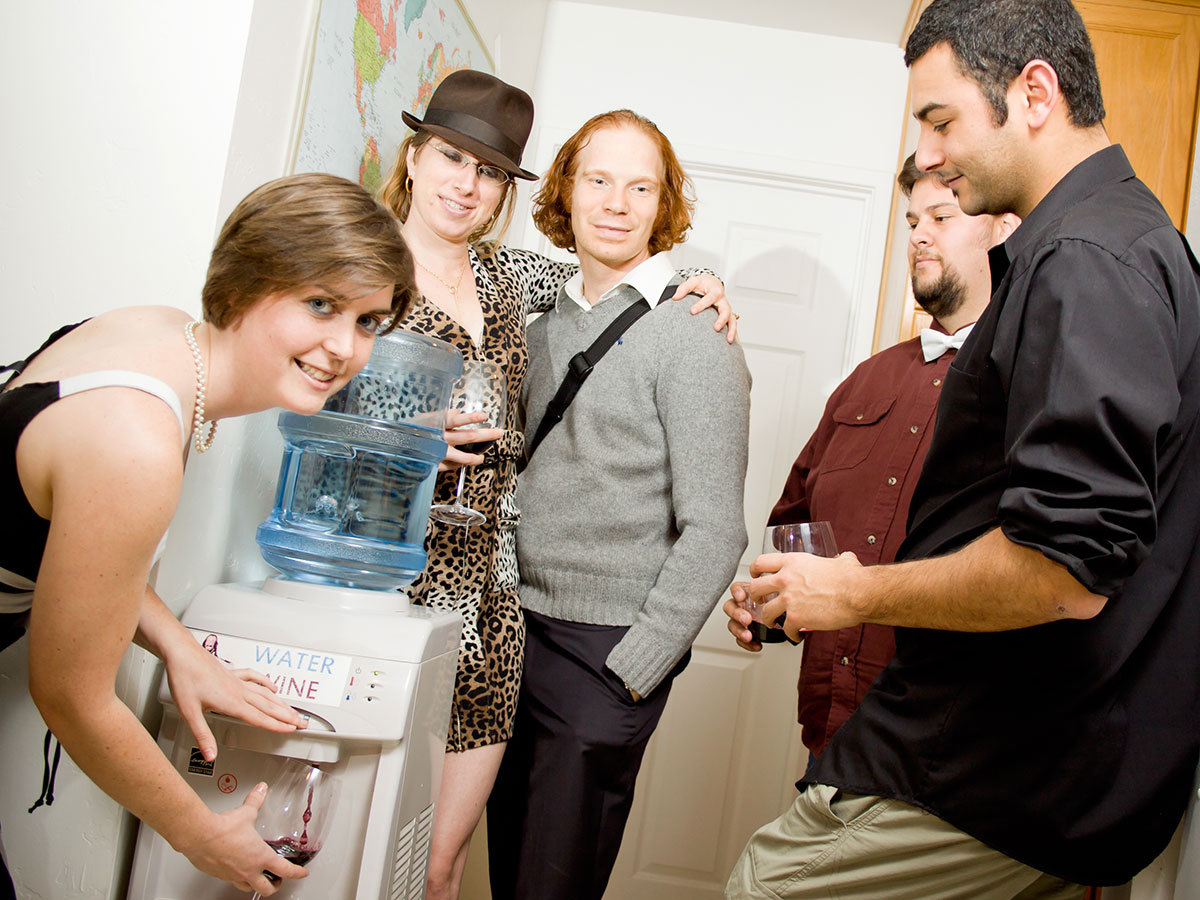
Our longhaired friend Greg was planning a Jesus-themed birthday party, and people joked about a cool possible prop: a machine that would seemingly convert water to wine. “Hey!” we thought. “We can do that!”
So we got to work, while the others just dreamed. A week before the party, we obtained a ceramic-crock water dispenser, sprinkler valves, aquarium pumps, and assorted PVC fittings. We made a glorious mess nearly every time we tried to create the illusion, because we would inadvertently start a siphon that we couldn’t stop.
At the last minute before the party, we made it work, but it wasn’t pretty. The wine container sat on a shelf behind the cooler while the guts of the system sat on the floor —all of it draped with sheets, making it obvious that some shenanigans were taking place. The partygoers were still impressed, and the effect was certainly delivered. But with our improved intuitions about fluid dynamics, we vowed to remake the Water-to-Wine Cooler as the awesome contraption it deserved to be.
We brainstormed by drawing block diagrams until we found a simple design we liked, then we shopped for a water cooler. An important requirement was the ability to electrically capture the mechanical action of the dispense button, covertly. We eventually found a GE water cooler that was perfect. It had hot and cold sides, so we could dispense wine out of the cold side, and for those in the know, room-temperature water from the hot side. We figured we could finish the project that same day; it ended up taking a couple weekends.
For the gurgling effect, we tried pumping air into the water bottle, without letting any water flow out. But we quickly saw that the excess pressure would have no place to go, unless we put a small vent in the top of the bottle — and if we did, water would back-flow through the air pump and start a siphon. Again.
Our solution was to hide an identical water bottle below, for the top one to drain into. This lets the water level decrease over the course of the party, which is more realistic. When the water gets low, you just swap the bottles, and you’re back in business. For easy during-party maintenance, we added a fill port for the wine and LED indicators to notify us if something needs attention.
The finished Water-to-Wine Cooler is indistinguishable from a normal water cooler, and we can stand at a distance and chuckle as our unsuspecting friends go from shock, to bewilderment, to amusement.
W2W Design
In the unmodified GE cooler, the inverted jug on top empties into a reservoir with two pipes coming out, one to the refrigeration unit and the other to the heating element. We rerouted one pipe directly to the hot water tap, and the other one to a gravity valve that controls flow to the second jug hidden inside the bottom of the cooler.
We also added a plastic reservoir that holds the wine for dispensing, a switch triggered by the cold water button, and the electronics and hydraulics to translate a button press into a simultaneous draining of water into the lower jug, and pumping of wine up into the cold-water tap.
Control comes from an ATmega AVR microcontroller development board with 4 relay outputs. The inputs to the board are a small switch triggered by the cold water tap, a water-empty float switch, and a wine-empty float switch. On the output side, 2 relays control the water drain valve solenoid and the pump that dispenses the wine. The board also controls 3 LEDs, swapped in for the GE cooler’s original status LEDs, which flash to show that the software is working and indicate empty water and empty wine inside.
Finally, a wine-full float sensor connects directly to an LED that shines through a small hole in back, bypassing the microcontroller, to let you know when to stop pouring refill wine. The W2W has a lot going on inside, but after you remove the compressor and heater from inside the cooler body, and if you use a 3-gallon jug in the bottom instead of a 5-gallon, it all fits.
The result? A miraculous illusion where water glugs down from the bottle to emerge mysteriously from the spigot as wine. To throw your own sacrilegious party, check out these complete build instructions.
Downloads
Grab our Water to Wine (W2W) code for the AVR microcontroller: https://github.com/partyrobotics/water-to-wine or git@github.com:partyrobotics/water-to-wine.git

MAKE Volume 34: Join the robot uprising! As MAKE's Volume 34 makes clear, there’s never been a better time to delve into robotics, whether you’re a tinkerer or a more serious explorer. With the powerful tools and expertise now available, the next great leap in robot evolution is just as likely to come from your garage as a research lab. The current issue of MAKE will get you started. Explore robot prototyping systems, ride along with the inventors of the OpenROV submersible, and learn how you can 3D-print your own cutting-edge humanoid robot for half the price. Plus, build a coffee-can Arduino robot, a lip balm linear actuator, a smartphone servo controller, and much more
On newsstands now, by subscription, or available in the Maker Shed



